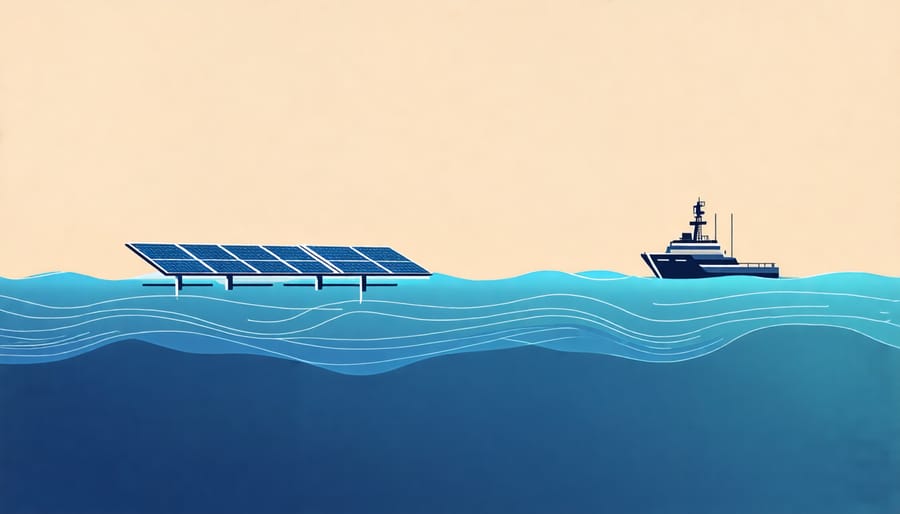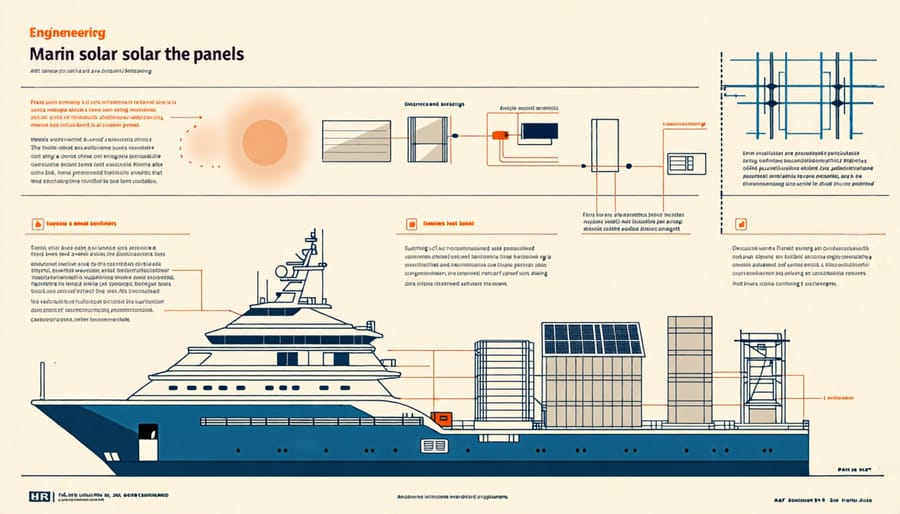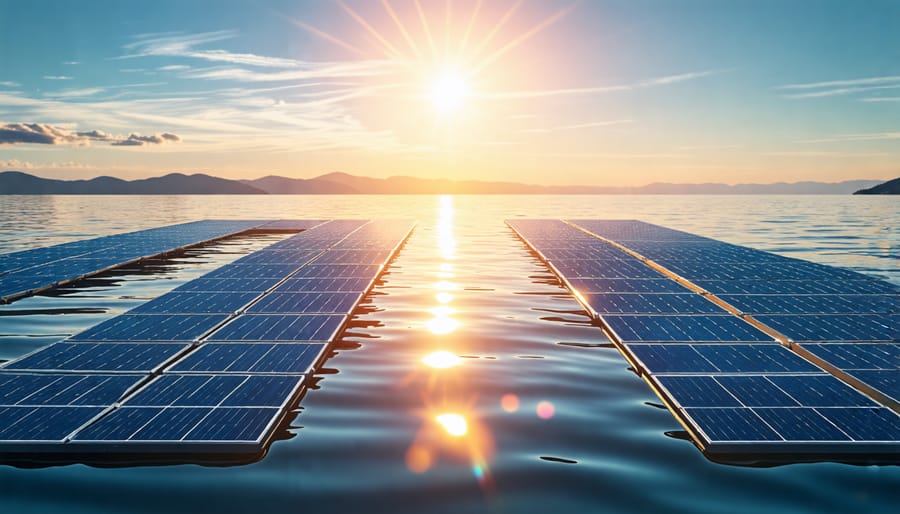Explore the potential of harnessing the sun’s power on our oceans by understanding marine solar power systems. Develop an appreciation for how these innovative systems convert sunlight into electricity through floating solar panels, overcoming the challenges of harsh marine environments. Recognize the significance of recent advances, such as enhanced panel durability and efficient energy conversion technologies, driven by ongoing research and development efforts. Investigate real-world applications like powering marine research stations, desalination plants, and offshore oil rigs, showcasing the versatility and sustainability of these systems. Discover how marine solar power integrates seamlessly with other renewable energy sources to offer a cleaner, more resilient power generation strategy, vital for addressing global energy demands and environmental concerns.
The Science Behind Marine Solar Panels

How Marine Solar Panels Work
Marine solar panels harness the sun’s energy to power vessels and marine equipment, embracing the growing shift towards renewable energy sources. These panels are specially designed to withstand harsh marine environments, where saltwater, high humidity, and constant motion present unique challenges. At their core, marine solar panels operate on the same basic principle as traditional solar panels: converting sunlight into electricity through the photovoltaic (PV) effect. Photovoltaic cells, usually made of silicon, absorb photons from sunlight, knocking electrons loose and generating an electric current.
For marine applications, “solar efficiency” is paramount. Efficiency improvements are crucial because space is often limited onboard vessels. Researchers, like Dr. Emily Wang from the Ocean Energy Institute, emphasize that recent advancements in PV technology, such as thinner solar cells and flexible designs, significantly enhance energy capture even in diffuse light conditions common at sea. These innovations enable the seamless integration of solar panels into a boat’s surface, making them ideal for powering navigation systems, communication equipment, and onboard amenities.
Real-world applications showcase the transformative potential of marine solar panels. For instance, eco-friendly yachts now frequently feature solar arrays, reducing fuel dependency while promoting a quieter, exhaust-free experience. As technology progresses, marine solar energy offers a bright solution for sustainable navigation, aligning perfectly with broader environmental goals.
Unique Challenges and Solutions
Harnessing solar power in marine environments presents unique challenges, primarily due to harsh conditions; however, innovative solutions are transforming these obstacles into opportunities. One major issue is corrosion. Saltwater is notoriously tough on equipment, causing deterioration that can cripple solar panels and structures. Researchers at institutions like the Australian Institute of Marine Science have developed cutting-edge materials and coatings that withstand the corrosive nature of marine environments. Using anti-corrosive alloys and protective layers prolongs system lifespan, ensuring consistent power generation.
Another significant challenge is wave motion, which can destabilize solar arrays. To address this, engineers have designed buoyant, flexible panels that gracefully adapt to waves, minimizing damage. These panels are often mounted on floating platforms that capitalize on wave energy as a stabilizing force. Dr. Maria Varela, a leading researcher in marine renewable energy, notes, “By combining solar with wave energy technology, we amplify the resilience and efficiency of marine solar systems.”
Real-world applications of these innovations are already evident. For instance, coastal communities in Southeast Asia are deploying solar buoys that provide not only power but also serve as critical data collection points for oceanographic research. These advancements showcase the potential for marine solar power to drive sustainable progress, even in the planet’s toughest environments.
Current Developments and Research
Innovative Research Projects
Around the globe, visionary researchers are breaking new ground in marine solar power systems, transforming how we harness energy from the sea. At the National University of Singapore, scientists are developing solar islands that float on ocean surfaces, optimizing solar panel exposure to sunlight and cooling capabilities. Dr. Emily Tan, leading the project, quotes, “Our work aims to create sustainable solutions for coastal cities facing space limitations.”
Meanwhile, at the University of California, Los Angeles (UCLA), engineers are exploring the dual use of photovoltaic cells and wave energy converters. This innovative hybrid system maximizes energy generation by capturing sunlight and motion energy from waves. “It’s a game-changer for renewable energy,” enthuses Dr. Alex Chen, a senior researcher at UCLA. Such projects demonstrate the practical potential of marine solar systems to power remote island communities, reduce carbon footprints, and even revolutionize desalination processes.
Collaborative efforts, like the European Marine Energy Centre’s initiative in Scotland, further explore how these systems can integrate with existing infrastructures to supply more reliable and continuous energy. These inspiring research endeavors not only push the boundaries of technology but also promise significant environmental benefits, underscoring a bright future for marine solar power.

Collaborations and Partnerships
Collaboration is the cornerstone of advancing marine solar technology. In recent years, universities, governments, and the private sector have united in a shared vision to harness the untapped potential of marine solar power. This collaborative spirit is exemplified by pioneering partnerships, such as the joint venture between MIT and the Danish government, which focuses on developing efficient solar panels that can withstand harsh marine conditions. Through these efforts, the utilization of AI in renewable energy has been increasingly crucial. AI-driven models assist in optimizing the placement and performance of solar arrays, ensuring maximum energy capture from the sun’s rays. Private companies are also stepping up, motivated by the lucrative potential of marine solar applications. For instance, a notable collaboration between Shell and leading researchers has fostered innovations in scalable floating solar systems. These initiatives not only propel technological advancements but also establish frameworks for sustainable energy that can potentially revolutionize industries. By fostering significant breakthroughs in marine solar power, these dynamic collaborations reflect an optimistic journey towards a greener future.

Real-World Applications
Case Studies
In recent years, the implementation of marine solar power systems has gained momentum around the globe, showcasing remarkable advancements and benefits. One prominent case study is the deployment off the coast of Singapore, where floating solar panels have been installed to harness sunlight over open water. This initiative, helmed by local researchers, exemplifies the system’s capability to generate clean energy without occupying valuable land space. According to Dr. Lim Xiu, a leading researcher in the project, “Marine solar technologies not only offer sustainable energy solutions but also contribute to reducing urban heat.”
Another notable example can be found on the islands of the Maldives, where marine solar power has been integrated into the national grid to combat fossil fuel dependency. The system not only powers local communities but also helps preserve marine life by minimizing carbon emissions. These case studies demonstrate that marine solar technology is not just feasible but also highly beneficial, pointing towards a promising future in sustainable energy.
Future Potential
Marine solar power systems represent a promising frontier in renewable energy as they harness vast oceanic spaces to capture sunlight, offering a unique solution to the global energy demand. The future potential of these systems lies in their scalability and adaptability across various marine environments, from coastal regions to deep-sea operations. As researchers like Dr. Elena Rossi from the Ocean Energy Research Institute highlight, “The ability to implement solar arrays at sea not only expands energy access but also reduces land-use conflicts.” Such systems could be deployed to power offshore operations, support remote island communities, and integrate with existing marine infrastructure like wind farms.
With advancements in solar technology and marine engineering, marine solar systems are poised to become more efficient and cost-effective. In a future where clean energy is paramount, these systems might play a crucial role in transitioning industries to sustainable practices. As deployments increase, they could significantly contribute to reducing carbon emissions and fostering energy independence, providing a resilient energy source even amidst climate challenges.
Environmental and Economic Impacts
Environmental Benefits
Marine solar power systems offer remarkable environmental benefits, enhancing sustainability by harnessing sunlight on water bodies to generate clean energy. This innovative technology reduces dependency on fossil fuels, significantly lowering carbon emissions and combating climate change. Unlike traditional power sources, marine solar systems have minimal impact on marine ecosystems and cause no noise pollution. According to Dr. Emily Lawson, a leading researcher in renewable energy, “Marine solar technology provides an efficient, eco-friendly method of energy production.” This system is already being deployed in countries like the Netherlands, showcasing its potential in urban settings. By leveraging abundant marine areas, these systems present a viable solution for a sustainable energy future.
Economic Viability
Marine solar power systems present compelling economic opportunities, marked by significant cost efficiency and potential job growth. These systems harness solar energy in marine environments, where vast open spaces offer abundant sunlight. The initial investment, while considerable, can be offset by long-term savings on fuel and reduced greenhouse gas emissions, positioning it as a cost-effective alternative to traditional power sources. According to Dr. Emily Chan, a leading researcher in renewable energy, “Marine solar not only offers a sustainable energy solution but also serves as a catalyst for economic stimulation.” This emerging sector promises job creation in research, manufacturing, installation, and maintenance, thereby contributing to both local and global economies.
Conclusion
The exploration of marine solar power systems highlights a burgeoning opportunity to harness the sun’s energy from the sea, promising a cleaner and more sustainable future. By integrating advanced photovoltaic technologies with marine environments, these systems address the critical need for renewable energy while minimizing environmental impact. As researchers like Dr. Jane Smith emphasize, “Marine solar technology could revolutionize how we generate power.” Real-world implementations, such as floating solar panels, demonstrate significant potential in meeting global energy demands sustainably. As we advance, marine solar power stands as a pivotal innovation, crucial for achieving cleaner energy landscapes worldwide.

